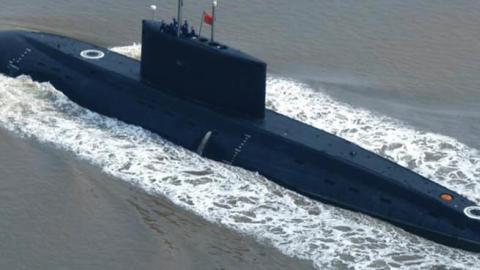President Trump recently declared that he wants to include China in the next nuclear-arms-control treaty, an objective consistent with his National Security Strategy (NSS) and his Pentagon’s National Defense Strategy (NDS). While this seems like a policy goal that arms-control and U.S. nuclear-disarmament advocates would embrace wholeheartedly, they didn’t. Why?
When the White House released the NSS in December 2017, it marked the first time since the Cold War that the United States recognized that the era of strategic competition with a peer rival has returned, with the Russian Federation largely displaced by the People’s Republic of China (PRC). The NSS stated, “For decades, U.S. policy was rooted in the belief that support for China’s rise and for its integration into the post-war international order would liberalize the Chinese Communist Party. Contrary to our hopes, China expanded its power at the expense of the sovereignty of others.” A new Cold War? Not quite. A return to great-power rivalry? Yes, and one that had actually been underway for some time.
The NDS, released in January 2018 shortly after the NSS, was also a revolutionary document. It announced that the era of the post–Cold War “peace dividend,” in which the United States and the West would have to worry only about small terrorist movements, was over. It stated, “The central challenge to U.S. prosperity and security is the reemergence of long-term, strategic competition by what the National Security Strategy classifies as revisionist powers,” which includes the PRC.
The strategies were not criticized when issued. In fact, a bipartisan commission of Republican and Democratic “graybeards” charged by Congress to evaluate the strategy widely praised its central premise: the long-term security competition of powers like the PRC.
The NSS recognized the many tools available to the United States to ensure the security of the American people — and that arms control could be one. At the same time, the administration has made clear in words and deeds that arms control would not be considered sacrosanct.
For example, when it came to the Joint Comprehensive Plan of Action (JCPOA) with the Islamic Republic of Iran or the Intermediate-Range Nuclear Forces (INF) Treaty with the Russian Federation, President Trump spent years trying to find deals that better served American security, and when improvements couldn’t be made or even basic compliance enforced, he withdrew.
At the same time, President Trump directed his administration to develop options to bring the PRC into nuclear-arms control because, as a long-term strategic competitor, its nuclear forces could not be allowed to continue to grow without limits.
One U.S. nuclear disarmament advocate wrote in the New Republic that, “while China’s ever-advancing capabilities are a cause for concern, proposals to ‘trilateralize’ nuclear arms control are nothing more than a poison pill” and “will be a wild goose chase.” But how can this be?
In a lengthy, unclassified statement in May 2019 at Hudson Institute, Defense Intelligence Agency (DIA) director Lieutenant General Robert Ashley described the activities of the key nuclear-weapons actors in the world, including the Russian Federation and the People’s Republic of China.
It is unusual for a senior leader of the intelligence community to give such public remarks about nuclear-weapons programs of adversaries. But his remarks were part of a campaign to educate the American people, on behalf of the entire U.S. intelligence community, about why the president felt it was important to begin to focus on China’s nuclear arms.
General Ashley stated, “Over the next decade, China will likely at least double the size of its nuclear stockpile in the course of implementing the most rapid expansion and diversification of its nuclear arsenal in China’s history.” He also noted that “China will soon field its own version of a nuclear triad” and its “military will be fully transformed into a first-tier force by 2050.”
A first-tier force? Double the size of its nuclear stockpile? Based on these statements, not only should the PRC be included in nuclear-arms control but, in fact, it must be. And controlling the growth of this nuclear stockpile should be a primary goal of all who claim to be concerned by proliferation of nuclear weapons.
However, instead of praising the president’s move, the nuclear-disarmament clerisy — a very small, but very loud and well-funded D.C. interest group — is focused on the extension of the New START Treaty and is fearful that talk of including the PRC is somehow an effort to kill it. But New START doesn’t expire until February 2021, and focus on it shouldn’t come at the expense of controlling growing nuclear stockpiles of the United States’ key strategic competitor. If and when President Trump makes a decision to extend the treaty, it can be done quickly and with no new negotiation.
The president is entirely right to try to bring the PRC into nuclear-arms control. It is already a party to the Biological Weapons Convention and the Chemical Weapons Convention and a signatory to the Comprehensive Test Ban Treaty. So, while it’s not opposed to arms control, the PRC has enjoyed a free ride on nuclear-arms control for too long. The United States and its allies cannot afford to wait until China goes from approximately 400 warheads to 800 warheads or 1,500 warheads before bringing the Chinese to the table.
Arms control is supposed to be about limiting threats to the United States and allies, not simply extending agreements that ignore major new threats. By standing in opposition to bringing China to the table, the U.S. nuclear-disarmament community runs the risk of undermining its core belief that arms control is a central pillar of national security. Because if the nuclear-disarmament community believes it isn’t a top national-security priority to bring the PRC into nuclear-arms control, maybe nuclear-arms control isn’t a national-security priority for it after all.
Read in "National Review":https://www.nationalreview.com/2020/03/china-arms-control-american-poli….















